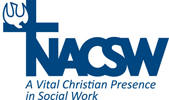Mission
NACSW’s mission is to equip its members to integrate Christian faith and professional social work practice.
Members
The members of NACSW represent a rich diversity of Christian denominations and traditions. NACSW recognizes that different Christian denominations and traditions use different language to express the heart of historic Christian faith, and supports the use of expressions such as the following examples for this purpose:
- “Jesus Christ is Lord and Savior” – stemming from passages such as Romans 10:9-10
- “In Christ, God reconciled the world to Himself” – stemming from Scriptural passages such as II Corinthians 5:19
- “We believe in One God, the Father who created us and all things, the Son who redeems us from sin and death, and the Holy Spirit who renews and sanctifies us.”
Christian Identity
By the term ‘Christian faith,’ NACSW means historic Christian faith as expressed, for example, in statements such as the following: The Apostle’s Creed, the Nicene Creed, and NACSW’s historic Statement of Faith and Practice.
I believe in God, the Father almighty, creator of heaven and earth. I believe in Jesus Christ, his only Son, our Lord. He was conceived by the power of the Holy Spirit and born of the Virgin Mary. He suffered under Pontius Pilate, was crucified, died, and was buried. He descended to the dead. On the third day he rose again. He ascended into heaven and is seated at the right hand of the Father. He will come again to judge the living and the dead. I believe in the Holy Spirit, the holy catholic Church, the communion of saints, the forgiveness of sins, the resurrection of the body, and life everlasting. Amen. We believe in one God, the Father, the Almighty, maker of heaven and earth, of all that is, seen and unseen. We believe in one Lord, Jesus Christ, the only Son of God, eternally begotten of the Father, God from God, Light from Light, true God from true God, begotten, not made, of one Being with the Father; through him all things were made. For us and for our salvation he came down from heaven, was incarnate of the Holy Spirit and the Virgin Mary and became truly human. For our sake he was crucified under Pontius Pilate; he suffered death and was buried. On the third day he rose again in accordance with the Scriptures; he ascended into heaven and is seated at the right hand of the Father. He will come again in glory to judge the living and the dead, and his kingdom will have no end. We believe in the Holy Spirit, the Lord, the giver of life, who proceeds from the Father and the Son, who with the Father and the Son is worshiped and glorified, who has spoken through the prophets. We believe in one holy catholic and apostolic Church. We acknowledge one baptism for the forgiveness of sins. We look for the resurrection of the dead, and the life of the world to come. Amen.Apostles’ Creed ¹
Nicene Creed ²
NACSW’s Historic Statement of Faith and Practice ³
Tenets emphasizing Christian beliefs: Tenets emphasizing human relationships and responsibilities: Tenets emphasizing vocation:
Reference Notes
¹ The Apostles’ Creed is used widely by a number of Christian denominations for both liturgical and catechetical purposes, including the Latin Rite of the Catholic Church, Lutheranism, the Anglican Communion, Presbyterians, Methodists, and Congregationalists. Its name comes from 5th-century tradition that, under the inspiration of the Holy Spirit after Pentecost, each of the Twelve Apostles dictated part of it. It was sent by Ambrose, who may be its author, to Pope Siricius in about 390. This is the English version of the Catechism of the Catholic Church maintaining the traditional division into twelve articles, the numbering of which is here added to the text ( Apostles’ Creed in Oxford Dictionary of the Christian Church (Oxford University Press 2005).
² The Nicene Creed is also used widely in Christian liturgy. It was adopted in the city of Nicaea, from which its name derives, by the first ecumenical council, which met there in the year 325 (Jeffrey, D. L. A Dictionary of Biblical tradition in English literature. Wm. B. Eerdmans Publishing, 1992). There are many versions; this one is published by the Presbyterian Church USA: Book of Confessions, (Louisville: Office of the General Assembly Presbyterian Church (U.S.A.), 2004), 1.1-3. The Nicene Creed has been normative to the Anglican Church, Assyrian Church of the East, Eastern Orthodox Church, Oriental Orthodox churches, the Roman Catholic Church including the Eastern Catholic Churches and the Old Catholic Church, the Lutheran Church and most Protestant denominations.
³ This Statement of Faith and Practice had a long history of being used by NACSW to summarize what members affirmed when joining or renewing membership with NACSW. Alan Keith-Lucas (b1910-d1995) played a key role in extensively revising this statement during the 1980s.

